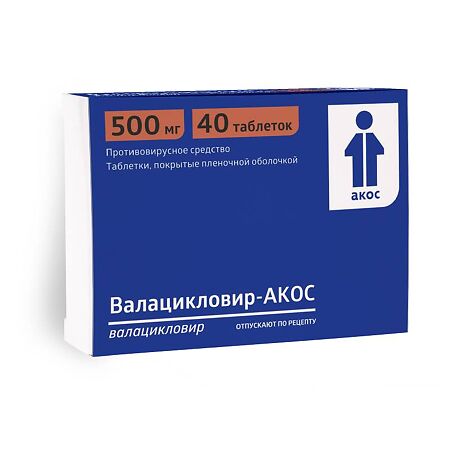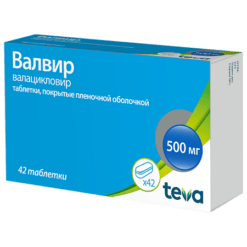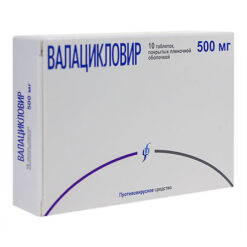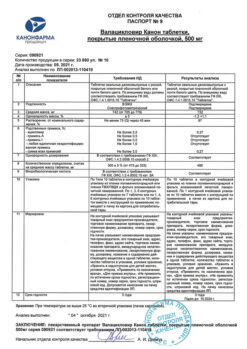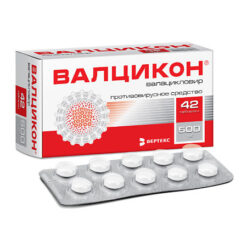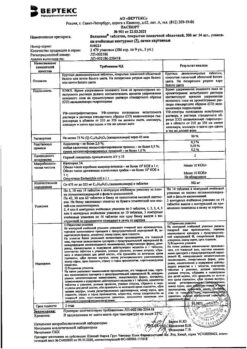No products in the cart.
Description
Pharmacotherapeutic group: antiviral medicine
ATX code: J05AB11
Pharmacological properties
Pharmacodynamics
The mechanism of action
Valacyclovir is an antiviral agent, it is an L-valine ester of acyclovir. Acyclovir is an analog of the purine nucleoside (guanine).
In the human body, valacyclovir is rapidly and almost completely converted to acyclovir and valine, presumably by the enzyme valacyclovirhydrolase.
Aciclovir is a specific herpes virus inhibitor with in vitro activity against herpes simplex virus (HPV) types 1 and 2; Varicella zoster virus (VZV); cytomegalovirus (CMV), Epstein-Barr virus (EBV) and human herpes virus type 6. Acyclovir inhibits the synthesis of viral DNA immediately after phosphorylation and transformation into the active form – acyclovirtriphosphate.
The first stage of phosphorylation requires activity of virus-specific enzymes. For HPV, VZV and VEB, this enzyme is viral thymidine kinase, which is present only in virus-affected cells. Part of the phosphorylation selectivity is maintained in cytomegalovirus indirectly through the product of the phosphotransferase gene UL97. This need for activation of acyclovir by a specific viral enzyme largely explains its selectivity.
The process of acyclovir phosphorylation (conversion from mono- to triphosphate) is completed by cellular kinases. Acyclovir triphosphate competitively inhibits viral DNA polymerase and, being a nucleoside analog, is incorporated into viral DNA, which leads to obligate breaking of the chain, cessation of DNA synthesis and, consequently, to blocking of virus replication.
Resistance to acyclovir is usually due to thymidine kinase deficiency, which leads to excessive spread of the virus in the host. In rare cases, decreased sensitivity to acyclovir is due to the emergence of virus strains with disrupted viral thymidine kinase or DNA polymerase structure. The virulence of these strains of the virus is similar to that of its wild strain.
. In an extensive study of HBV and EHV strains sampled from patients treated with acyclovir or used as prophylaxis, it was found that viruses with hypersensitivity to Valacyclovir are extremely rare but may be found in rare cases in patients with severe immune impairments, such as bone marrow or organ transplant recipients, patients receiving chemotherapy for malignancies, and HIV-infected individuals.
Valacyclovir helps control pain: It reduces the duration of pain and decreases the percentage of patients with pain caused by herpes zoster, including acute post-herpetic neuralgia.
Pharmacokinetics
Intake
After oral administration, valacyclovir is well absorbed from the gastrointestinal tract,
converting quickly and almost completely to acyclovir and valine. This conversion is probably carried out by the liver enzyme valacyclovir hydrolase.
The bioavailability of acyclovir is 54% when taking valacyclovir at a dose of 1000 mg or more and is not reduced by food intake. Valacyclovir pharmacokinetics is not dose-dependent. The rate and extent of absorption decrease with increasing dose, leading to a less proportional increase in maximum plasma concentration (Cmax) compared to the therapeutic dose range and decreased bioavailability at doses above 500 mg.
Table 1. Results of acyclovir pharmacokinetics assessment of single doses of valacyclovir from 250 mg to 2,000 mg in healthy volunteers with normal hepatic function
/p>
Pharmacokinetic parameters of acyclovir | 250 mg (N=15) | 500 mg (N=15) | 1000 mg (N=15) | 2000 mg (N=8) | |
Cmax | μmol/L | 9.78 ± 1.71 | 15.0 ± 4.23 | 23.1 ± 8.53 | 36.9 ± 6.36 |
µg/ml | 2.20 ± 0.38 | 3.37 ± 0.95 | 5.20 ± 1.92 | 8.30 ± 1.43 | |
Tmax | hours (h) | 0.75 (0.75-1.5) | 1.0 (0.75-2.5) |
2.0 (1.5-3.0) | |
AUC | h ∙ μmol/l | 24.4 ± 3.65 | 49.3 ± 7.77 | 83.9 ± 20.1 | 131 ± 28.3 |
h ∙ µg/ml | 5.50 ± 0.82 | 11.1 ± 1.75 | 18.9 ± 4.51 | 29.5 ± 6.36 | |
Cmax – maximum plasma concentration;
Tmax – time to reach maximum plasma concentration;
AUC – area under the pharmacokinetic concentration-time curve. The Cmax and AUC values reflect the mean standard deviation. The values for Tmax reflect the median value and range of values.
The maximum plasma concentration of valacyclovir is only 4% of that of acyclovir, with a median time of 30 to 100 min after drug administration. Within 3 hours after drug administration, valacyclovir concentration reaches the level of quantification or lower.
Valacyclovir and acyclovir have similar pharmacokinetic parameters after single and multiple dosing. VZV and HPV do not significantly change the pharmacokinetics of valacyclovir and acyclovir after oral valacyclovir administration.
Distribution
The degree of binding of valacyclovir to plasma proteins is very low (15%). The degree of penetration into the cerebrospinal fluid (CSF) is determined as the ratio of AUC in CSF to AUC in plasma and is about 25% for acyclovir and metabolite 8-hydroxyaciclovir (8-ON-ACV); about 2.5% for metabolite 9-(carboxymethoxy)methylguanine (CMMG).
Metabolism
After oral administration, valacyclovir is converted to acyclovir and L-valine via presystemic metabolism in the intestine and/or hepatic metabolism. Acyclovir is converted into minor metabolites: CMG by ethyl alcohol and aldehyde dehydrogenase; 8-OH-ACV by aldehydoxidase. Approximately 88% of the total cumulative effect on blood plasma is attributable to acyclovir, 11% to CMG, and 1% to 8-OH-ACV. Valacyclovir and acyclovir are not metabolized by cytochrome P450 isoenzymes.
In patients with normal renal function the elimination half-life of acyclovir from the blood plasma after single or multiple doses of valacyclovir is about 3 hours. Less than 1% of the administered dose of valacyclovir is excreted unchanged by the kidneys. Valacyclovir is excreted by the kidneys primarily as acyclovir (more than 80% of the dose taken) and acyclovir metabolite – SMMG.
Patients with impaired renal function
Aciclovir excretion correlates with renal function, exposure to acyclovir increases with the severity of renal failure. In patients with end-stage renal failure, the average half-life of acyclovir after valacyclovir administration is about 14 hours, compared to about 3 hours with normal renal function.
Exposure of acyclovir and its metabolites CMG and 8-OH-ACV in plasma and CSF was assessed at steady state after multiple doses of valacyclovir in 6 patients with normal renal function (mean creatinine clearance 111 mL/min, range 91-144 mL/min) receiving 2000 mg every 6 hours and in 3 patients with severe renal failure (mean creatinine clearance 26 mL/min, range 17-31 mL/min) receiving 1500 mg every 12 hours. In severe renal failure compared with normal renal function, plasma concentrations of acyclovir, SMMG and 8-OH-ACV were 2, 4 and 5-6 times higher, respectively, in plasma as well as in CSF. There was no difference in the penetration of acyclovir in CSF (defined as the ratio of AUC in CSF to AUC in plasma), CMG or 8-OH-ACV between the two populations with severe renal failure and normal renal function.
Patients with impaired hepatic function
Pharmacokinetic data show that in patients with hepatic impairment the rate of conversion of valacyclovir to acyclovir is reduced, but not the extent of this conversion. The half-life of acyclovir is independent of hepatic function.
Pregnancy
A study of the pharmacokinetics of valacyclovir and acyclovir in late pregnancy found an increase in the steady state daily AUC of valacyclovir at a daily dose of 1000 mg daily, which was approximately 2 times the AUC when acyclovir was taken orally at a dose of 1200 mg daily.
HIV infection
In patients with HIV infection, the distribution and pharmacokinetic characteristics of acyclovir remain unchanged after oral administration of one or more doses of 1000 mg or 2000 mg of valacyclovir compared to healthy volunteers.
Organ transplantation
The maximum concentration of acyclovir in patients after organ transplantation receiving 2000 mg valacyclovir 4 times daily was comparable to or higher than the maximum concentration observed in healthy volunteers receiving the same dose. The established daily AUC values can be characterized as markedly higher.
Indications
Indications
Adults and teenagers aged 12 to 18 years
– Treatment of infections of the skin and mucous membranes caused by HSV, including newly diagnosed and recurrent genital herpes (Herpes genitalis), as well as labial herpes (Herpes labialis).
– Prevention (suppression) of recurrent infections of the skin and mucous membranes caused by HSV, including genital herpes, including in adults with immunodeficiency.
– Prevention of infections caused by cytomegalovirus (CMV) and diseases after solid organ transplantation.
Adults
– Treatment of herpes zoster (Herpes zoster) and ophthalmic herpes zoster.
Pharmacological effect
Pharmacological effect
Pharmacotherapeutic group: antiviral agent
ATX code: J05AB11
Pharmacological properties
Pharmacodynamics
Mechanism of action
Valaciclovir is an antiviral agent, an L-valine ester of acyclovir. Acyclovir is an analogue of purine nucleoside (guanine).
In the human body, valacyclovir is quickly and almost completely converted to acyclovir and valine, presumably under the influence of the enzyme valacyclovir hydrolase.
Acyclovir is a specific inhibitor of herpes viruses with in vitro activity against herpes simplex viruses (HSV) types 1 and 2; varicella zoster virus (VZV); cytomegalovirus (CMV), Epstein-Barr virus (EBV) and human herpes virus type 6. Acyclovir inhibits the synthesis of viral DNA immediately after phosphorylation and conversion to the active form – acyclovir triphosphate.
The first stage of phosphorylation requires the activity of virus-specific enzymes. For HSV, VZV and EBV, this enzyme is viral thymidine kinase, which is present only in cells affected by the virus. Phosphorylation selectivity is partially maintained in cytomegalovirus indirectly through the product of the UL97 phosphotransferase gene. This requirement for activation of acyclovir by a specific viral enzyme largely explains its selectivity.
The process of phosphorylation of acyclovir (conversion from mono-to triphosphate) is completed by cellular kinases. Acyclovir triphosphate competitively inhibits viral DNA polymerase and, being a nucleoside analogue, is incorporated into viral DNA, which leads to obligate chain breakage, cessation of DNA synthesis and, consequently, blocking viral replication.
Resistance to acyclovir is usually caused by a deficiency of thymidine kinase, which leads to excessive spread of the virus in the host. In rare cases, a decrease in sensitivity to acyclovir is due to the emergence of virus strains with a disruption in the structure of the viral thymidine kinase or DNA polymerase. The virulence of these variants of the virus resembles that of the wild strain.
Based on the results of an extensive study of HSV and VZV strains collected from patients receiving aciclovir therapy or using it for prophylaxis, it was established that viruses with reduced sensitivity to valacyclovir are extremely rare, but can be found in rare cases in patients with severe immunocompromise, for example, bone marrow or organ transplant recipients, patients receiving chemotherapy for malignancy, and HIV-infected people.
Valacyclovir helps relieve pain: reduces its duration and reduces the percentage of patients with pain caused by herpes zoster, including acute postherpetic neuralgia.
Pharmacokinetics
Suction
After oral administration, valacyclovir is well absorbed from the gastrointestinal tract.
quickly and almost completely converted into acyclovir and valine. This conversion is probably carried out by the liver enzyme valacyclovir hydrolase.
When taking valacyclovir in a dose of 1000 mg, the bioavailability of acyclovir is 54% and is not reduced by food intake. The pharmacokinetics of valacyclovir is not dose-dependent. The rate and extent of absorption decrease with increasing dose, resulting in a less proportionate increase in maximum plasma concentration (Cmax) compared to the therapeutic dose range and decreased bioavailability at doses above 500 mg.
Table 1. Results of assessing the pharmacokinetics of acyclovir when taking single doses of valacyclovir from 250 mg to 2000 mg in healthy volunteers with normal liver function
Pharmacokinetic parameters of acyclovir
250 mg
(N=15)
500 mg
(N=15)
1000 mg
(N=15)
2000 mg
(N=8)
Сmax
µmol/l
9.78 ± 1.71
15.0 ± 4.23
23.1 ± 8.53
36.9 ± 6.36
µg/ml
2.20 ± 0.38
3.37 ± 0.95
5.20 ± 1.92
8.30 ± 1.43
Тmax
hours (h)
0.75
(0.75-1.5)
1.0
(0.75-2.5)
2.0
(0.75-3.0)
2.0
(1.5-3.0)
AUC
h ∙ µmol/l
24.4 ± 3.65
49.3 ± 7.77
83.9 ± 20.1
131 ± 28.3
h ∙ µg/ml
5.50 ± 0.82
11.1 ± 1.75
18.9 ± 4.51
29.5 ± 6.36
Cmax – maximum concentration in blood plasma;
Tmax is the time until the maximum concentration in the blood plasma is reached;
AUC is the area under the concentration-time pharmacokinetic curve. The Cmax and AUC values reflect the average standard deviation. Values for Tmax reflect the median value and range of values.
The maximum concentration of valacyclovir in blood plasma is only 4% of the concentration of acyclovir, the median time to reach it ranges from 30 to 100 minutes after taking the drug. 3 hours after dosing, the concentration of valacyclovir reaches the level of quantitative determination or below.
Valacyclovir and acyclovir have similar pharmacokinetic parameters after single and multiple doses. VZV and HSV do not significantly alter the pharmacokinetics of valacyclovir and acyclovir after oral administration of valacyclovir.
Distribution
The degree of binding of valacyclovir to plasma proteins is very low (15%). The extent of penetration into the cerebrospinal fluid (CSF) is defined as the ratio of AUC in CSF to AUC in plasma and is about 25% for acyclovir and the metabolite 8-hydroxyacyclovir (8-OH-ACV); about 2.5% for the metabolite 9-(carboxymethoxy)methyl-guanine (CMMG).
Metabolism
After oral administration, valacyclovir is converted to acyclovir and L-valine through first-pass metabolism in the intestine and/or hepatic metabolism. Acyclovir is converted into small metabolites: CMMG under the influence of ethyl alcohol and aldehyde dehydrogenase; 8-OH-ASV under the influence of aldehyde oxidase. Approximately 88% of the total cumulative plasma exposure is due to acyclovir, 11% to CMMG and 1% to 8-OH-ACV. Valacyclovir and acyclovir are not metabolized by isoenzymes of the cytochrome P450 system.
Removal
In patients with normal renal function, the half-life of acyclovir from the blood plasma after a single or multiple doses of valacyclovir is approximately 3 hours. Less than 1% of the administered dose of valacyclovir is excreted unchanged by the kidneys. Valacyclovir is excreted from the body by the kidneys mainly in the form of acyclovir (more than 80% of the dose taken) and the metabolite of acyclovir – CMMG.
Special patient groups
Patients with impaired renal function
The elimination of acyclovir correlates with renal function, and acyclovir exposure increases with the severity of renal failure. In patients with end-stage renal disease, the mean half-life of acyclovir following valacyclovir administration is approximately 14 hours, compared with approximately 3 hours in those with normal renal function.
Exposure of acyclovir and its metabolites CMMG and 8-OH-ACV in plasma and CSF was assessed at steady state after multiple doses of valacyclovir in 6 patients with normal renal function (mean creatinine clearance 111 ml/min, range 91-144 ml/min) receiving 2000 mg every 6 hours, and in 3 patients with severe renal impairment (mean creatinine clearance 26 ml/min, range 17-31 ml/min) receiving 1500 mg every 12 hours. In severe renal failure, compared with normal renal function in the blood plasma, as well as in the CSF, the concentrations of acyclovir, CMMG and 8-OH-ASV were 2, 4 and 5-6 times higher, respectively. There was no difference in the extent of acyclovir penetration into the CSF (defined as the ratio of CSF AUC to plasma AUC), CMMG, or 8-OH-ACV between the two populations with severe renal impairment and normal renal function.
Patients with liver dysfunction
Pharmacokinetic data show that in patients with hepatic impairment, the rate of conversion of valacyclovir to acyclovir is reduced, but not the extent of this conversion. The half-life of acyclovir is independent of liver function.
Pregnancy
A study of the pharmacokinetics of valacyclovir and acyclovir in late pregnancy found an increase in the daily AUC value at steady state when taking valacyclovir daily at a dose of 1000 mg per day, which was approximately 2 times higher than the AUC when taking oral acyclovir at a dose of 1200 mg per day.
HIV infection
In patients with HIV infection, the distribution and pharmacokinetic characteristics of acyclovir after oral administration of one or more doses of 1000 mg or 2000 mg of valacyclovir remain unchanged compared with healthy volunteers.
Organ transplantation
The maximum concentration of acyclovir in organ transplant patients receiving 2000 mg valacyclovir 4 times daily was comparable to or higher than the maximum concentration observed in healthy volunteers receiving the same dose. The established daily AUC values can be characterized as noticeably higher.
Special instructions
Special instructions
Hydration
In patients at risk of dehydration, especially in elderly patients, it is necessary to ensure adequate water and electrolyte balance.
Use in patients with impaired renal function and in elderly patients
Since acyclovir is excreted by the kidneys, it is necessary to reduce the dose of Valaciclovir-AKOS in patients with impaired renal function. Elderly patients may experience impaired renal function, so dose reduction should be considered in this group of patients. Both elderly patients and patients with impaired renal function are at increased risk of developing neurological complications; such patients should be provided with careful medical supervision. As a rule, these reactions are mostly reversible if the drug is discontinued.
Treatment of labial herpes and prevention of CMV infections and diseases
The use of high doses of the drug Valaciclovir-AKOS for liver dysfunction and after liver transplantation
There is no data on the use of Valacyclovir-AKOS in high doses (4000 mg per day or higher) in patients with liver disease, so high doses of Valacyclovir-AKOS should be prescribed to such patients with caution. No special studies have been conducted to study the effect of the drug Valaciclovir-AKOS in liver transplantation. However, it has been found that prophylactic administration of high doses of acyclovir reduces the manifestations of CMV infection and disease.
Use for genital herpes
Patients should be advised to abstain from sexual intercourse if symptoms are present, even if treatment with the antiviral drug Valaciclovir-AKOS has already been started. Suppressive therapy with Valacyclovir-AKOS reduces the risk of transmission of genital herpes, but does not completely eliminate the risk of infection and does not lead to a complete cure. Therapy with Valacyclovir-AKOS is recommended in combination with reliable means of barrier contraception.
Impact on the ability to drive vehicles and machinery
During treatment, caution should be exercised when driving vehicles and engaging in other potentially hazardous activities.
No special studies have been conducted. It is necessary to take into account the patient’s clinical condition and the profile of adverse reactions of valacyclovir when assessing the patient’s ability to drive vehicles and machinery.
Active ingredient
Active ingredient
Valaciclovir
Composition
Composition
Core composition:
Active ingredient: valacyclovir hydrochloride – 556.2 mg (in terms of valacyclovir – 500 mg);
Excipients: calcium stearate, povidone-K90 (kollidon 90 F, plasdon K90), crospovidone, colloidal silicon dioxide (Aerosil), talc, microcrystalline cellulose;
Shell composition: hypromellose (hydroxypropyl methylcellulose), macrogol – 4000 (polyethylene oxide 4000, polyethylene glycol 4000), titanium dioxide (titanium dioxide).
Pregnancy
Pregnancy
Fertility
In animal studies, valacyclovir had no effect on fertility. However, high doses of parenteral acyclovir have been associated with testicular effects in rats and dogs.
No studies have been conducted on the effects of valacyclovir on fertility in humans. However, no changes in sperm count, motility or morphology were observed in 20 patients after 6 months of daily use of valacyclovir in doses ranging from 400 mg to 1000 mg.
Pregnancy
There are limited data on the use of valacyclovir during pregnancy. The drug should be used during pregnancy only if the potential benefit to the mother outweighs the potential risk to the fetus.
Pregnancy registries documented pregnancy outcomes in women taking valacyclovir or other drugs containing acyclovir (acyclovir is the active metabolite of valacyclovir), with 111 and 1246 cases, respectively (of which 29 and 756 taking the drugs in the first trimester of pregnancy) representing pregnancy outcomes recorded prospectively. Analysis of data from the registry of pregnant women exposed to acyclovir did not reveal an increase in the number of birth defects in their children compared with the general population, and no specificity or pattern was found for any of the malformations that would indicate a common cause. Since the registry of pregnant women included a small number of women who took valacyclovir during pregnancy, reliable and definite conclusions about the safety of valacyclovir during pregnancy cannot be made.
Breastfeeding period
Acyclovir, the main metabolite of valacyclovir, passes into breast milk. After taking valacyclovir at a dose of 500 mg orally, Cmax in breast milk was 0.5-2.3 times (on average 1.4 times) higher than the corresponding concentrations of acyclovir in maternal blood plasma. The ratio of acyclovir AUC values in breast milk to maternal serum AUC ranged from 1.4 to 2.6 (mean 2.2). The mean concentration of acyclovir in breast milk was 2.24 μg/ml (9.95 μmol/L). When the mother takes valacyclovir at a dose of 500 mg 2 times a day, breastfed children are exposed to the same effects of acyclovir as when it is taken orally at a dose of about 0.61 mg/kg/day. The half-life of acyclovir from breast milk is the same as from blood plasma.
Valacyclovir unchanged was not detected in maternal plasma, breast milk or infant urine.
Valaciclovir should be administered with caution to women during breastfeeding.
However, intravenous acyclovir is used to treat HSV in infants at a dose of 30 mg/kg/day.
Contraindications
Contraindications
– Hypersensitivity to valacyclovir, acyclovir or any other component of the drug.
– Children’s age up to 12 years.
– Children under 18 years of age in the treatment of herpes zoster and ophthalmic herpes zoster.
With caution
When used simultaneously with nephrotoxic drugs, renal failure, pregnancy, lactation, clinically pronounced forms of HIV infection.
Side Effects
Side Effects
Adverse reactions are listed below according to the classification according to the main systems and organs and the frequency of occurrence, which was defined as follows: very often: > 1 in 10, often: > 1 in 100 and 1 in 1000 and 1 in 10,000 and < 1 in 1000, very rarely: < 1 in 10,000.
Clinical trial data
From the nervous system
Often: headache.
From the gastrointestinal tract
Common: nausea.
Post-marketing data
From the blood system and hematopoietic organs
Very rare: leukopenia, thrombocytopenia. Basically, leukopenia was observed in patients with reduced immunity.
From the immune system
Very rare: anaphylaxis.
From the nervous system and psyche
Rarely: dizziness, confusion, hallucinations, depression of consciousness.
Very rare: agitation, tremor, ataxia, dysarthria, psychotic symptoms, convulsions, encephalopathy, coma. The symptoms listed above are mostly reversible and are usually observed in patients with impaired renal function or other predisposing conditions. In adult organ transplant patients receiving high doses (8 g per day) of valacyclovir for the prevention of CMV infection, neurological reactions develop more often than when taking lower doses.
From the respiratory system and mediastinal organs
Uncommon: shortness of breath.
From the gastrointestinal tract
Rarely: abdominal discomfort, vomiting, diarrhea.
From the liver and biliary tract
Very rare: reversible abnormalities in liver function tests, which are sometimes regarded as manifestations of hepatitis.
From the skin and subcutaneous fat
Uncommon: rashes, including manifestations of photosensitivity.
Rarely: itching.
Very rare: urticaria, angioedema.
From the urinary system
Uncommon: hematuria (often associated with other renal disorders).
Rarely: renal dysfunction.
Very rare: acute renal failure, renal colic. Renal colic may be associated with impaired renal function.
Cases of precipitation of acyclovir crystals in the lumen of the renal tubules have been reported. It is necessary to maintain an adequate drinking regime during treatment.
Other: Cases of renal failure, microangiopathic hemolytic anemia and thrombocytopenia (sometimes in combination) have been observed in patients with severe immunocompromise, especially in adult patients with advanced HIV infection, receiving high doses of valacyclovir (8 g daily) for a long period of time. Similar complications were noted in patients with the same underlying and/or concomitant diseases, but not receiving valacyclovir.
Interaction
Interaction
Clinically significant interactions have not been established.
Acyclovir is excreted by the kidneys, mainly unchanged through active renal secretion. The combined use of drugs with this elimination mechanism may lead to an increase in the concentration of acyclovir in the blood plasma.
After the administration of valacyclovir at a dose of 1000 mg and the drugs cimetidine, probenecid, which are eliminated in the same way as valacyclovir, an increase in the AUC of acyclovir is observed and, thus, the renal clearance of acyclovir is reduced. However, due to the broad therapeutic index of acyclovir, no dose adjustment of valacyclovir is required.
In the treatment of labial herpes, prevention and treatment of diseases caused by CMV, caution must be exercised in the case of simultaneous use of valacyclovir in higher doses (4000 mg per day or higher) and drugs that compete with acyclovir for the elimination route, since there is a potential threat of increasing the plasma concentration of one or both drugs or their metabolites. An increase in the AUC of acyclovir and the inactive metabolite mycophenolate mofetil (an immunosuppressant used in organ transplant patients) was observed when these drugs were administered concomitantly.
Concomitant use of valacyclovir with nephrotoxic drugs, including aminoglycosides, organic platinum compounds, iodinated contrast agents, methotrexate, pentamidine, foscarnet, cyclosporine and tacrolimus should be carried out with caution, especially in patients with impaired renal function, and requires regular monitoring of renal function.
Overdose
Overdose
Symptoms
Acute renal failure and neurological impairment, including confusion, hallucinations, agitation, depression and coma, as well as nausea and vomiting, have been observed in patients receiving doses of valacyclovir higher than recommended. Such conditions were more often observed in patients with impaired renal function and elderly patients who received repeated higher than recommended doses of valacyclovir due to non-compliance with the dosage regimen.
Treatment
Patients should be under close medical supervision. Hemodialysis significantly promotes the removal of acyclovir from the blood and can be considered the method of choice in the management of patients with an overdose of the drug.
Storage conditions
Storage conditions
In a place protected from light, at a temperature not exceeding 25 ° C.
Keep out of the reach of children.
Shelf life
Shelf life
3 years.
Do not use after expiration date.
Manufacturer
Manufacturer
Sintez, Russia
Additional information
| Shelf life | 3 years. Do not use after the expiration date. |
|---|---|
| Conditions of storage | In the dark place at a temperature not exceeding 25 °С. Store out of the reach of children. |
| Manufacturer | Sintez OAO, Russia |
| Medication form | pills |
| Brand | Sintez OAO |
Other forms…
Related products
Buy Valacyclovir-ACOS, 500 mg 40 pcs with delivery to USA, UK, Europe and over 120 other countries.

